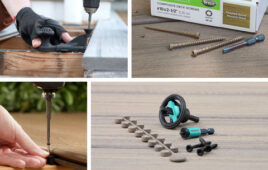Written by Jody Muelaner

A hex-head screw has a hexagonal-shaped head thatcan be tightened with a spanner or socket
Hex-head screws are screws with a hexagonal-shaped head that can be tightened with a wrench (spanner) or socket, which engages with the external faces of the hex head. These types of fasteners have an external hexagon head and should not be confused with a hexagon socket head or an Allen — which has an internal hexagonal socket that can be driven by hex bits or keys.
A screw is a mechanical fastener with a threaded shaft that installs directly into a part. The term hex-head screw typically refers to a machine screw, with a preformed machine thread. Machine screws resemble bolts but their entire shaft is usually threaded.
Wood screws and self-tapping screws may sometimes also have a hex head when high torque is required. Wood screws and self-topping screws, however, have a tapered shaft with sharp threads that are designed to cut a mating thread in the part to which they are fastened.
Some hex-head screws have a slotted or Philips head in conjunction with a standard hex head so that a screwdriver can be used when if a wrench or socket is unavailable or inconvenient. This may be referred to as a Combi screw.
Hex-head screws may have full-bearing heads, washer heads, or flanged heads with bonded washers. They’re available in zinc-plated steel, galvanized steel, organic coated steel, stainless steel, bronze, nylon, or bi-metal.
Hex-head screws designed to mate with a machine thread, also known as hex-cap screws, setscrews, or machine screws and are used to secure an object within or against another object.
American National Standard and Unified Standard Heavy Hex Screws and Hex-cap Screws ANSI/ASME B18.2.1-1996, specify the screws ideal size range is 0.25–3 in (6.35–76.20 mm) in diameter.
Certain types of these screws are designed to tap their own hole (also known as lag screws or coach screws) and are often used to:
- Join heavy timber or heavy objects onto timber
- Attach heavy objects to masonry
- Attach light objects to timber or steel.
These types of hex-head screws have a tapered point that can be easily inserted into a pilot hole or nylon plug, which is a sharpened point designed to pierce timber or light gauge steel, or a gimlet point designed for the displacement of timber.
Self-drilling hex head screws or Tek screws, are used for joining metal to metal. These types of hex-head fasteners have a fluted tip that self-drills when installed, eliminating the need for a pilot hole.
Self-drilling, hex-head screws have a drill point of varying length depending on the thickness of the metal that the fastener is being fixed to.





Tell Us What You Think!